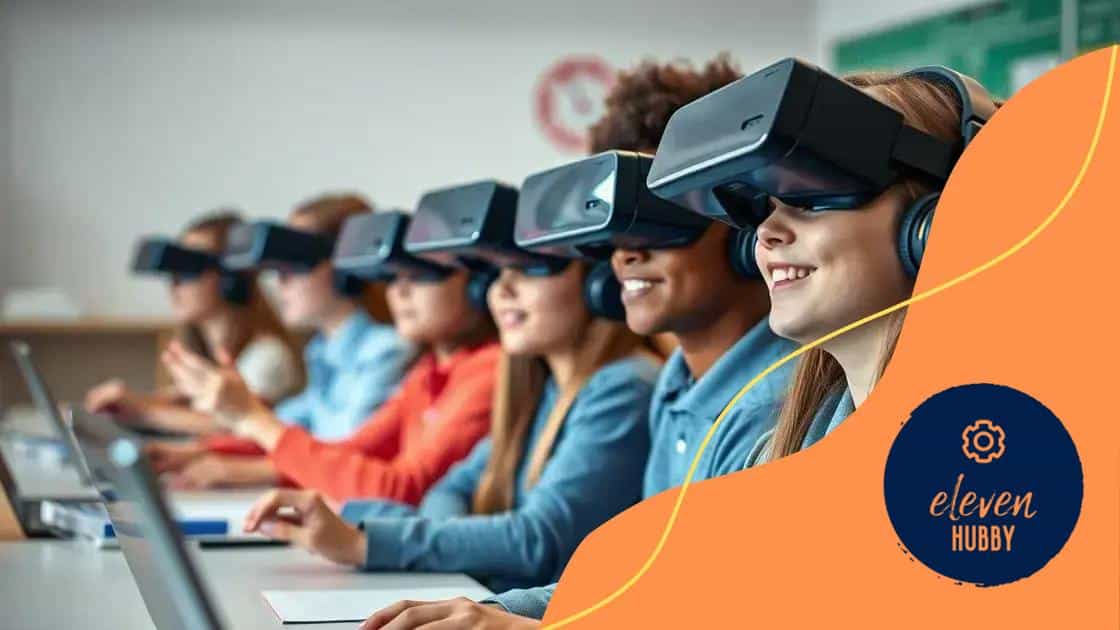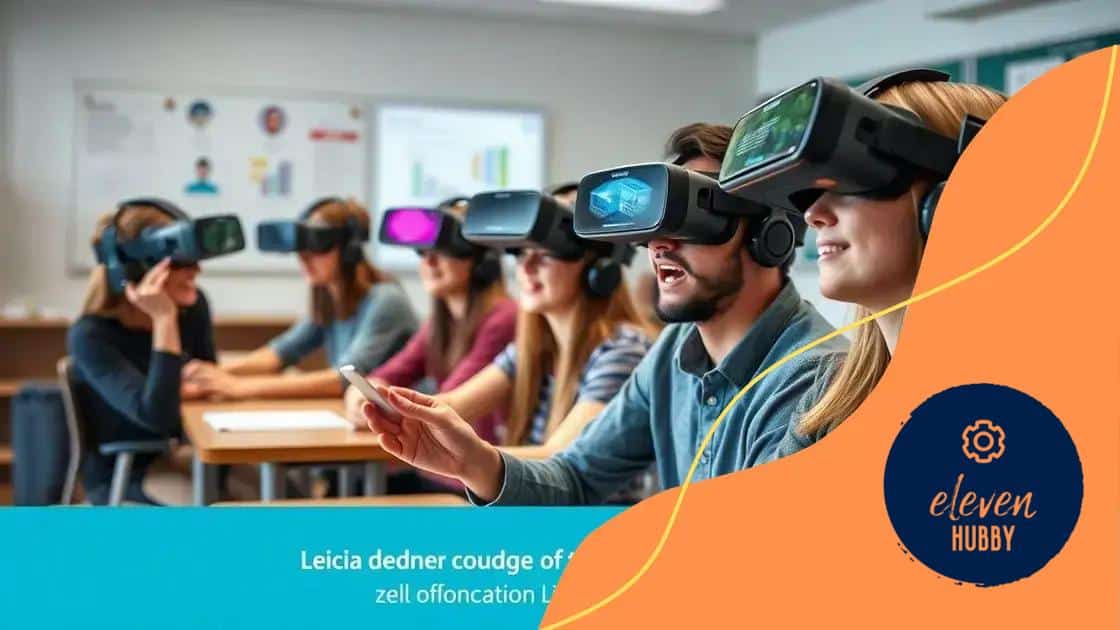How mixed-reality is enhancing STEM education

Mixed-reality is enhancing STEM education by providing immersive experiences that engage students, facilitate hands-on learning, and connect theoretical concepts to real-world applications, despite challenges like cost and training.
How mixed-reality is enhancing STEM education opens up exciting possibilities for students and teachers alike. Imagine learning about complex scientific concepts through immersive environments that stimulate curiosity and understanding. Intrigued? Let’s dive into how these technologies are reshaping learning experiences.
The role of mixed-reality in STEM education
The role of mixed-reality in STEM education is becoming increasingly important as technology evolves. This approach blends the physical and digital worlds, providing students with unique learning experiences. By utilizing mixed-reality tools, educators can enhance understanding and engagement in complex subjects.
Benefits of Mixed-Reality in Learning
Mixed-reality environments allow for exploration and experimentation that traditional classrooms cannot offer. Students can interact with 3D models, conduct virtual experiments, and visualize scientific concepts in a way that captures their attention.
- Improves retention of knowledge
- Encourages collaboration among students
- Makes learning interactive and fun
- Provides instant feedback and assessment opportunities
One significant advantage of mixed-reality is the ability to simulate real-world situations. For instance, students can practice engineering designs or medical procedures in a safe, controlled environment. This hands-on experience helps solidify their understanding and builds essential skills.
Additionally, mixed-reality can cater to different learning styles. Visual learners benefit from immersive imagery, while kinesthetic learners engage through interaction. This adaptability makes mixed-reality an effective tool for diverse classrooms, meeting the needs of all students.
Implementation of Mixed-Reality Tools
Implementing mixed-reality in classrooms requires careful planning. Educators should select the right tools and ensure that they align with educational goals. Training for both teachers and students is crucial for maximizing the effectiveness of these technologies.
- Choose user-friendly applications
- Provide training sessions for teachers
- Add mixed-reality projects to the curriculum
By thoughtfully integrating mixed-reality into STEM education programs, schools can provide a richer learning experience. As students immerse themselves in these environments, they develop critical thinking skills and foster a love for learning. The potential is limitless, making mixed-reality a transformative force in education.
Enhancing engagement through immersive experiences
Enhancing engagement through immersive experiences is a vital component in modern education, especially in STEM fields. When students can experience lessons in a fully immersive environment, their interest and participation significantly increase. This engagement is crucial for effective learning and retention.
Why Immersive Experiences Matter
Immersive experiences allow students to engage with the material on a deeper level. By using technologies like virtual reality (VR) and augmented reality (AR), classrooms become places where students can explore and experiment. Instead of passively receiving information, they actively participate in their learning journeys.
- Increases student motivation
- Helps in understanding complex concepts
- Allows for hands-on practice in a safe environment
Moreover, immersive experiences cater to individual learning preferences. Visual learners thrive on the sights and sounds of augmented environments, while kinesthetic learners benefit from hands-on interactions. This adaptability fosters a more inclusive classroom presence.
Examples of Immersive STEM Learning
Many schools have started incorporating immersive experiences into their STEM curriculums. For example, students can take virtual field trips to distant planets or dive deep into the ocean without leaving the classroom. These activities make learning exciting and relevant. They encourage questions and foster curiosity among students.
- Virtual labs for conducting science experiments
- Simulations for engineering design processes
- Interactive environments for exploring biological systems
As students immerse themselves in these experiences, they build a strong understanding of the topics at hand. Their excitement becomes apparent as they explore and create. Learning through immersive experiences not only builds knowledge but also nurtures a lifelong passion for discovery.
Benefits of using mixed-reality technologies

The benefits of using mixed-reality technologies in education are vast and impactful. These technologies bridge the gap between theoretical concepts and real-world applications, helping students visualize and interact with complex subjects.
Interactive Learning
One major advantage is the interactivity that mixed-reality provides. Students can manipulate 3D models and experiment with simulations, which leads to better understanding and retention of information. This hands-on approach encourages deeper engagement with course material.
- Promotes critical thinking skills
- Enhances problem-solving abilities
- Caters to different learning styles
Moreover, the immersive experience creates a stimulating environment for learning. It captivates students’ attention, making lessons more enjoyable and memorable. The excitement of exploring digital worlds encourages students to stay curious and motivated.
Real-World Applications
The practical applications of mixed-reality technologies are significant. For example, students studying architecture can walk through their designs in a virtual space, gaining insights that would be difficult to achieve through traditional methods. Similarly, in science classes, students can observe chemical reactions or biological processes in a controlled virtual setting.
- Facilitates collaboration on projects
- Offers safe environments for risky practices
- Reduces the gap between classroom learning and real-world scenarios
These technologies also prepare students for future careers. As industries adopt mixed-reality tools, students familiar with this technology will have a competitive edge. They develop skills that are increasingly relevant in today’s job market, such as digital literacy and technical proficiency.
Real-world applications of mixed-reality in learning
The real-world applications of mixed-reality in learning are transforming the educational landscape. By merging digital content with physical environments, students gain practical experience in various subjects. This innovative approach enables learners to better connect theory with application.
STEM Fields
In science, technology, engineering, and mathematics (STEM), mixed-reality is particularly beneficial. For instance, students can conduct virtual experiments in chemistry without the risks associated with real chemicals. They can observe molecular structures in 3D, allowing for a deeper understanding of complex concepts.
- Experiments in virtual labs
- Interactive simulations for problem-solving
- 3D visualization of scientific phenomena
Engineering students can explore virtual designs and models, making adjustments in real-time. This hands-on approach helps them grasp complicated processes and enhances their design skills.
Medical Education
In medical training, mixed-reality technologies provide invaluable resources. Medical students can practice surgical procedures in a simulated environment that mimics real-life scenarios. They learn anatomy through immersive 3D models, improving their understanding of human bodies.
- Virtual surgeries for practice
- 3D anatomical models for study
- Simulations of patient interactions
These experiences help future doctors and nurses gain confidence before they enter the hospital. The ability to interact with real-world situations through mixed-reality bridges the gap between classroom learning and practical application.
History and Art
Mixed-reality can also enhance learning in history and art. Students can take virtual field trips to historical sites or museums, exploring artifacts and artworks in a more engaging way. This immersive experience makes history come alive, making students more interested in their studies.
- Exploration of ancient civilizations
- Art interaction through virtual galleries
- Recreation of historical events
These applications demonstrate how mixed-reality enriches the educational experience across disciplines. As schools continue to adopt these technologies, students will be better prepared for future careers and real-world challenges.
Challenges and future of mixed-reality in education
The challenges and future of mixed-reality in education present both obstacles and opportunities for educators and students alike. As technologies evolve, it’s essential to address the barriers that may hinder the effective implementation of mixed-reality tools in schools.
Challenges in Implementation
One significant challenge is the cost of mixed-reality technologies. Not all schools can afford the necessary equipment and software, leading to disparities in access to these innovative learning tools. Additionally, the lack of training for teachers can prevent them from fully utilizing mixed-reality in their classrooms. Without proper integration into the curriculum, the potential of mixed-reality remains untapped.
- High costs of devices and software
- Insufficient training for educators
- Lack of infrastructure and support
Another challenge is the need for robust internet access. Many educational institutions, especially in underfunded areas, struggle with connectivity issues. This limitation can hinder the use of online mixed-reality platforms and resources, creating a gap in educational equality.
Future Possibilities
Despite these challenges, the future of mixed-reality in education looks promising. As technology advances, we can expect more affordable and accessible solutions. Innovations may lead to low-cost devices that can effectively deliver mixed-reality experiences to diverse classrooms. Furthermore, companies are beginning to recognize the potential impact of mixed-reality in education, driving research and development to create better tools.
- Advancements in affordable VR and AR technologies
- Increased focus on teacher training and resources
- Collaboration between educational institutions and tech companies
As mixed-reality becomes more integrated into educational settings, it’s likely that we will see a significant shift in teaching methodologies. Educators will have new ways to engage students, catering to diverse learning needs and preferences. Students will benefit from immersive experiences that promote collaborative learning and critical thinking.
By overcoming existing challenges and embracing future advancements, mixed-reality has the potential to revolutionize education, making learning more engaging, interactive, and effective for all students.
FAQ – Frequently Asked Questions about Mixed-Reality in Education
What are mixed-reality technologies?
Mixed-reality technologies combine the real world with digital content, allowing users to interact with both in an immersive environment.
How do mixed-reality tools enhance learning?
These tools make learning more engaging by providing interactive experiences that help students understand complex concepts better.
What challenges exist in implementing mixed-reality in schools?
Challenges include high costs, lack of teacher training, and insufficient infrastructure in some schools.
What does the future hold for mixed-reality in education?
The future is promising, with advancements in technology expected to make mixed-reality tools more accessible and affordable for schools.






